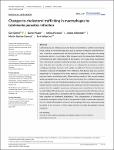Changes to cholesterol trafficking in macrophages by Leishmania parasites infection
Semini, Geo
Paape, Daniel
Paterou, Athina
Schroeder, Juliane
Barrios-Llerena, Martin
Aebischer, Toni
Leishmania spp. are protozoan parasites that are transmitted by sandfly vectors during blood sucking to vertebrate hosts and cause a spectrum of diseases called leishmaniases. It has been demonstrated that host cholesterol plays an important role during Leishmania infection. Nevertheless, little is known about the intracellular distribution of this lipid early after internalization of the parasite. Here, pulse-chase experiments with radiolabeled cholesteryl esterified to fatty acids bound to low-density lipoproteins indicated that retention of this source of cholesterol is increased in parasite-containing subcellular fractions, while uptake is unaffected. This is correlated with a reduction or absence of detectable NPC1 (Niemann–Pick disease, type C1), a protein responsible for cholesterol efflux from endocytic compartments, in the Leishmania mexicana habitat and infected cells. Filipin staining revealed a halo around parasites within parasitophorous vacuoles (PV) likely representing free cholesterol accumulation. Labeling of host cell membranous cholesterol by fluorescent cholesterol species before infection revealed that this pool is also trafficked to the PV but becomes incorporated into the parasites’ membranes and seems not to contribute to the halo detected by filipin. This cholesterol sequestration happened early after infection and was functionally significant as it correlated with the upregulation of mRNA-encoding proteins required for cholesterol biosynthesis. Thus, sequestration of cholesterol by Leishmania amastigotes early after infection provides a basis to understand perturbation of cholesterol-dependent processes in macrophages that were shown previously by others to be necessary for their proper function in innate and adaptive immune responses.
Dateien zu dieser Publikation
Keine Lizenzangabe

